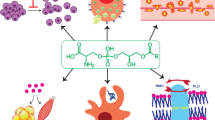Abstract.
Though the mitogenic activity of lysophosphatidic acid (LPA) has been wellestablished through classical studies, its mechanism of action was long obscure. Recent identification and cloning of LPA-specific receptors has led to the elucidation of the G-proteins and signaling pathways through which this molecule functions. In addition to its mitogenic properties, recent reports have suggested that LPA may also promote cell survival. This review will summarize the current literature regarding LPA signaling and its role as an antiapoptotic factor.
Similar content being viewed by others
Author information
Authors and Affiliations
Additional information
Received 13 March 2000; revised 25 April 2000; accepted 25 April 2000
Rights and permissions
About this article
Cite this article
Swarthout*, J., Walling, H. Lysophosphatidic acid: receptors, signaling and survival . CMLS, Cell. Mol. Life Sci. 57, 1978–1985 (2000). https://doi.org/10.1007/PL00000678
Issue Date:
DOI: https://doi.org/10.1007/PL00000678




